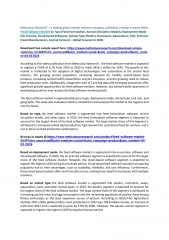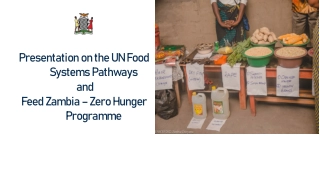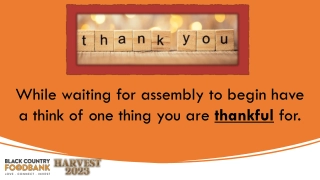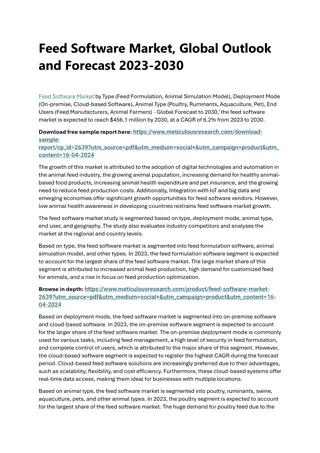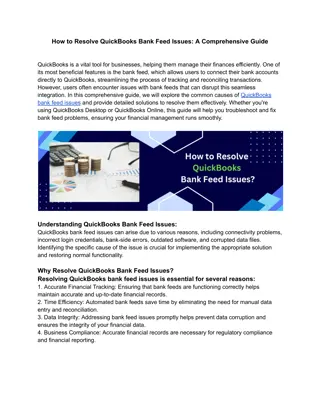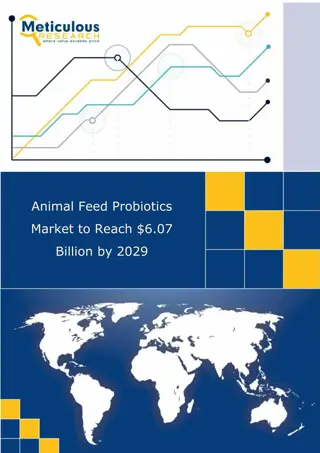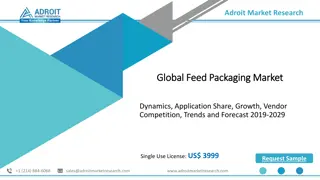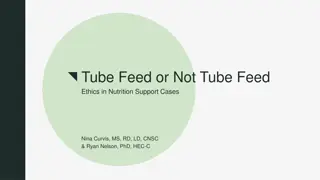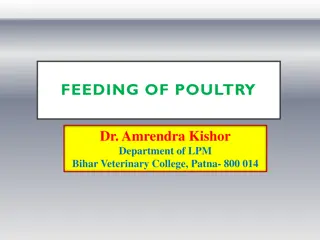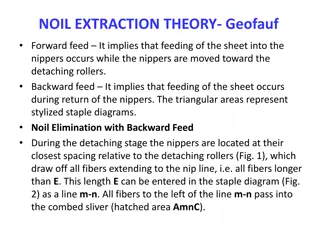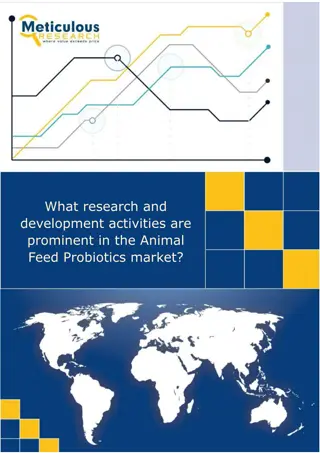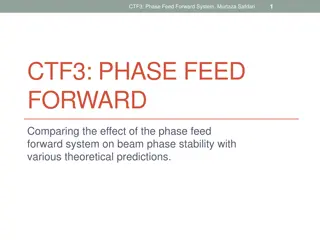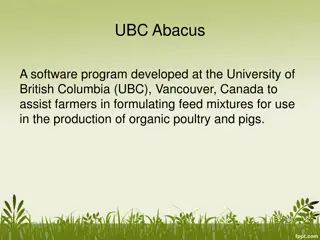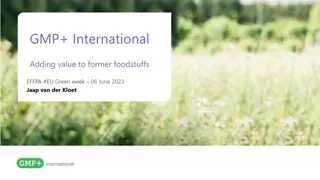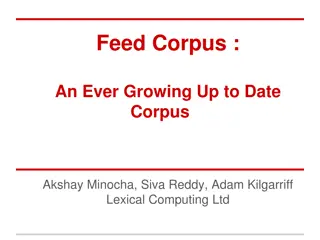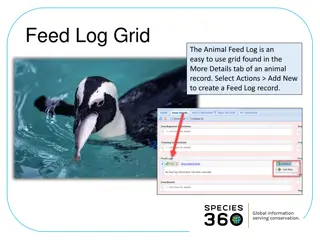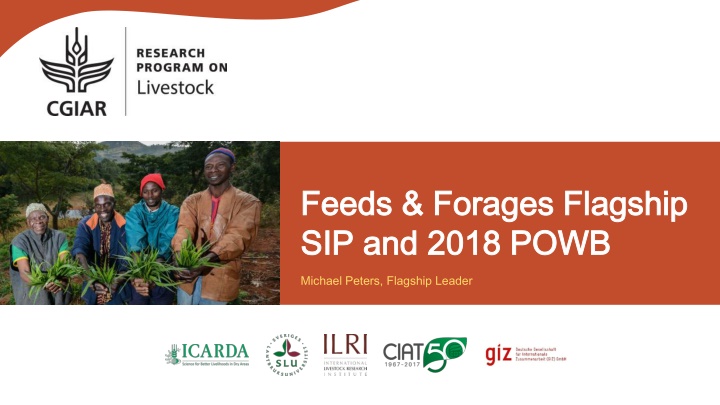
Livestock Feed Solutions and Innovations for Sustainable Agriculture
Explore Flagship Feeds & Forages' key objectives to synthesize global knowledge on livestock feed options, develop improved feed and genetic options, target enhanced feed utilization, and scale innovative technologies with stakeholders. Drive productivity, reduce labor, and empower women in small-scale production systems while enhancing livestock-tree-crop efficiency.
Download Presentation

Please find below an Image/Link to download the presentation.
The content on the website is provided AS IS for your information and personal use only. It may not be sold, licensed, or shared on other websites without obtaining consent from the author. If you encounter any issues during the download, it is possible that the publisher has removed the file from their server.
You are allowed to download the files provided on this website for personal or commercial use, subject to the condition that they are used lawfully. All files are the property of their respective owners.
The content on the website is provided AS IS for your information and personal use only. It may not be sold, licensed, or shared on other websites without obtaining consent from the author.
E N D
Presentation Transcript
Feeds & Forages Flagship Feeds & Forages Flagship SIP and SIP and 2018 POWB 2018 POWB Michael Peters, Flagship Leader
Key objectives Key objectives, outcomes and targets , outcomes and targets Flagship s Flagship s objectives objectives Synthesize global knowledge on livestock feed options Synthesize global knowledge on livestock feed options and package it into widely available tools for feed solution targeting (Cluster 1). Develop improved feed and forage genetic options Develop improved feed and forage genetic options that are better suited to abiotic/biotic pressures such as drought and disease/pests and that improve the efficiency of livestock-tree-crop systems as a whole, achieving higher productivity at lower resource use (land, water, fertilizer, labour among others) (Cluster 2). Target, test and disseminate feed, fodder and forage utilization and processing options to make Target, test and disseminate feed, fodder and forage utilization and processing options to make better use of existing feed resources better use of existing feed resources in small-scale production systems undergoing rapid inclusive or fragile growth (Cluster 3). Take promising new and existing feed and forage technologies to scale Take promising new and existing feed and forage technologies to scale, by developing, testing and implementing innovative business models and scaling approaches together with the value chain stakeholders (Cluster 4).
Key objectives Key objectives, outcomes and targets , outcomes and targets Outcomes Outcomes to 2022 to 2022 1 1. .13 13 million million poor inputs through optimized feeding strategies, including rations and processing across 11 countries. 1 1. .18 18 million million poor poor households households (5.4 million individuals) realizing 30% increase, on average, in livestock productivity through the use of improved feeding options and strategies, in 12 countries. Improved Improved feeding feeding practices practices that reduce women's labour and energy expenditure by 10% developed and disseminated, reaching 1.6 million women in 12 countries. poor households households (5.1 million individuals) efficiently using
Key Key flagship outputs per Cluster of flagship outputs per Cluster of Activity (COA) Activity (COA) COA 1 COA 1 COA 2 COA 2 COA 3 COA 3 COA 4 COA 4 On-farm feed assessment and prioritization approaches developed, tested and applied Large-scale feed assessments developed to support decision making and prioritization at national level Global knowledge products and tools developed to allow focused effort on likely feed intervention winners in key geographies Forage and rangeland genotypes identified for specific agro- ecologies and production systems Forage cultivars bred and available for multi-locational testing and/or release in tropical and sub-tropical environments Tools, ontologies and platforms developed to increase breeding efficiency Crop cultivars genetically enhanced to include and increase their feed value On-farm and small business feed processing technologies developed, piloted and promoted On-farm and small business drying and ensiling protocols developed, piloted and promoted Agronomic practices and use of indigenous rangeland species defined New gender- and youth-sensitive business models developed, piloted and validated to enhance seed supply, feed transaction and feed processing New gender- and youth-sensitive extension approaches developed, piloted and validated to increase uptake of feed and forage technologies Approaches for private sector producer linkages developed, piloted and validated to increase innovation potential and technology uptake in the feeds and forages sector
Current structure of the Flagship Current structure of the Flagship Our core Flagship group Flagship Management: Flagship Management: Michael Peters (CIAT, FP lead); Stefan Burkart (CIAT, admin support) COA1 COA1 feed and COA2 COA2 COA3 COA3 COA4 COA4 Diagnosis opportunities decision-support tools for prioritizing and targeting feed and forage interventions of constraints development and of Development of new feed and forage options Using existing feed resources better Facilitating the delivery and uptake of feed and forage technologies Alan Duncan (ILRI, Lead) Alan Duncan (ILRI, Lead) Chris Jones (ILRI) Michael Bl mmel (ILRI) Ben Lukuyu (ILRI) Barbara Rischkowsky (ICARDA) Michael Peters (CIAT) Stefan Burkart (CIAT) Valheria Valheria Castiblanco Castiblanco (CIAT, Lead) Jacobo Arango (CIAT) Michael Peters (CIAT) Solomon Mwendia (CIAT) Chris Jones (ILRI) Shinan Kassam (ICARDA) Barbara Rischkowsky (ICARDA) Michael Bl mmel (ILRI) Juan Cardoso (CIAT) Stefan Burkart (CIAT) (CIAT, Lead) Michael Michael Bl mmel Mounir Louhaichi (ICARDA) Jane Wamatu (ICARDA) Ewa Wredle (SLU) Bl mmel (ILRI, Lead) (ILRI, Lead) Uwe Ohmstedt (CIAT, Lead) Uwe Ohmstedt (CIAT, Lead) Udo R diger (ICARDA) Stefan Burkart (CIAT) Paul Sch tz (GIZ) Ewa Wredle (SLU) Cross Cross- -Cutting staff Cutting staff Jane Poole (ILRI, M&E) Iddo Dror (ILRI, capdev) n.n. (CAC, capdev) n.n. (ILRI, comms) Wouter Kleijn (ILRI, youth) Nicoline de Haan (ILRI, gender) Wendy Godek (CIAT CAC, gender) Birhanu Lenjisu (ILRI EA, gender) Carolina Roa (CIAT, IP, tbd)
CONVENTIONS CONVENTIONS Green: Green: already achieved Yellow: Yellow: will be achieved until end 2017 Red: Red: delayed, will not be achieved until end 2017 Update of progress for the 2017 POWB Update of progress for the 2017 POWB Cluster of Activity (COA) Cluster of Activity (COA) Activity Coding Activity Coding Deliverables 2017 Deliverables 2017 Green Green Yellow Yellow Red Red 1) Feed demand scenario for specific locations COA1 COA1: Diagnosis of feed : Diagnosis of feed constraints and opportunities and constraints and opportunities and development of decision development of decision- -support tools for prioritizing and targeting tools for prioritizing and targeting feed and forage interventions feed and forage interventions 3.1.1: Refined local, national and regional feed supply and demand analysis and option tools 2) 3 issues of the Tropical Grasslands-Forrajes Tropicales Online Journal published support 3) Contribution to legume CHOICE tool documented 3.2.1: Knowledge updating: New equations for stationary and mobile NIRS integrated into platform for Colombia and Ethiopia. 3.2.1: Forage genotypes that have the potential to withstand abiotic and biotic stresses, reduce soil degradation and curb greenhouse gas emissions. 1) New equations for stationary and mobile NIRS; mobile Nirs explored for Ethiopia (diversity of feed stuff) and Colombia (forage breeding) 1) List of promising Urochloa hyrids defined 1) New crosses of breeding lines 3.2.2: Superior apomictic Urochloa and Megathyrsus hybrids 2) Forage hybrids scaled to 100,000 hectares in at least 15 countries 1) Documented conceptualization for potential to improve phenotyping efficiency and explore options of genomic selection 3.2.3: Open-access genomic tools, forage crop ontologies and phenotyping platforms that increase breeding efficiency 2) Collection of P.purpureum genotyped 1) Key rangeland species including Cactae characterized COA2 COA2: Development of new feed : Development of new feed and forage options and forage options 3.2.4: Indigenous, introduced and well adapted forage, rangeland and cactus species and accessions identified, characterized and introduced 2) Climate smart Brachiaria developed 3) Core collection of Panicum maxium characterized 1) Potential of genetic enhancement rice, wheat, barley and cowpea documented 2) Cultivars of maize, rice, wheat, cowpea and promising material of barley identified 3.2.5: Key full-purpose crop cultivars that have enhanced residue fodder traits (in collaboration with other CRPs) 3) Options for genetic slection of maize and wheat investigated 4) Sorghum and pearl millet phenotyped in lab and tested with dairy producres 3.3.1: Viable strategies for matching feed processing options with smallholder capacity 3.3.2: Scalable drying and ensiling protocols for smallholders, to conserve feeds and by-products 1) Draft Feed-Supply-Demand tool developed COA3 COA3: Using existing feed : Using existing feed resources better resources better 1) Comparison of commercial versus farmer produced silage documented
CONVENTIONS CONVENTIONS Green: Green: already achieved Yellow: Yellow: will be achieved until end 2017 Red: Red: delayed, will not be achieved until end 2017 Update of progress for the 2017 POWB Update of progress for the 2017 POWB Cluster of Activity (COA) Cluster of Activity (COA) Activity Coding Activity Coding Deliverables 2017 Deliverables 2017 Green Green Yellow Yellow Red Red Report in French and English available 1) One synthesis report prepared containing information on the national seed workshop on forage seed sector in Tunisia and lessons learned 2) Four businesses plans are established with feed block manufacturing small and medium enterprises in Tunisia 3 Factsheets in 3 languages available 3.4.1: Business models and road maps for gender- and youth-sensitive small-scale seed supply, feed transaction and processing enterprises 3) Report on fact sheets for silage, feed blocks and seed production 4) One cost-benefit analysis presented for forage technolgies in Central Kenya 5) One method prepared for cost-benefit analysis of improved forage technologies in Colombia 6) One method prepared for the qualitative analysis of adoption factors around improved forage technologies in Colombia Cluster 4: Facilitating the Cluster 4: Facilitating the delivery and uptake of feed delivery and uptake of feed and forage technologies and forage technologies 1) Report on Baseline survey in Tunisia 3.4.2: Recommendations for effective extension approaches and financial mechanisms, market information systems for scaling up forage and feed technologies (evaluated for their cost-effectiveness, sustainability, benefits to women and young people and accountability to clients) 2) Livestock producers in Central Kenya trained on improved forage technologies and documented in a report This is still pending on the continuity of funding for the second half of 2017 3) Gaps around promising forage technologies identified for Colombia and documented in a report 1) Two regional Innovation Platforms (IP) established around feed resources in the red meat VC in Tunisia. At least two multi stakeholder IP meetings have taken place with at least 30 % women participating. A report will be provided 2) Exchange with private seed sector established for Central Kenya and documented in a report 3) CIAT's forage concepts discussed with the stakeholders of the Colombian Roundtable for Sustainable Cattle Production. A report will be provided 4) CIAT's forage concepts promoted to a broad range of actors of the cattle and dairy VCs in Colombia in coordination with the Colombian Roundtable for Sustainable Cattle Production. A report will be provided 3.4.3: Recommendations for developing links between private-sector actors and small-scale producers for the delivery of forage and feed technologies
How 2017 activities informed for 2018 How 2017 activities informed for 2018 All 2017 activities are being developed under bilateral/W3 projects as no W1/2 funds are available. Through BMZ-ACIAR Gap Funding for our COA2 COA2 breeding and COA4 to maintain core forage and food-feed crop breeding activities and to start preparing for scaling. These will be essential inputs for the work continuing in 2018 to 2022. The rewriting of our Flagship proposal helped to refine major activities for 2018 onwards based on our experiences made in 2017 and following a much more outcome and demand driven approach. The following changes were applied: COA4 scaling work, we were able COA1 COA1 COA2 COA2 COA3 COA3 COA4 COA4 Our focus on the development of tools was shifted towards the assessment and prioritization of interventions at different levels (on-farm, large-scale, global) with the aim to inform development under Clusters 2 and 3 and scaling approach development under Cluster 4. Our feed and forage breeding and selection activities were grouped according to the most important traits and production systems. Our approach is now more comprehensive. We grouped our activities under three levels of intervention: on-farm feed processing, off-farm feed processing and rangeland management. No major changes but now better integrated in the ToC. technology
How 2017 activities informed for 2018 How 2017 activities informed for 2018 Specific 2017 activities that informed for 2018: COA 1 COA 1 COA 3 COA 3 We will continue refining our prioritization and assessment tools in 2018 for being able to pilot and test them from 2019 onwards. 2017 work showed that we are still in the discovery phase for most of our activities. This will continue in 2018 and partly 2019 and we expect to enter the delivery phase from 2019/2020 onwards. COA 2 COA 2 COA 4 COA 4 Our breeding and selection efforts in 2017 showed that we are still in the discovery phase for most of the materials we work on. This will continue in 2018 and also in 2019. After that, new materials can be delivered to public and private sector partners for transformation and scaling. The Brachiaria hybrids that already have been delivered to our private sector partners are being scaled and show continuous growth rates in terms of adoption. This will be continued in 2018 and we will seek to cooperate more strongly with our private sector partners in order to support their scaling activities. Through bilateral funds, we were able to generate required knowledge necessary for the development of new business models, new extension approaches and producer-private sector-linkages. These inputs are a first step towards achieving our milestones. In 2018 we will continue with discovery in order to generate the missing knowledge parts for then being able to develop and pilot new business models, extension and scaling approaches from 2019/2020 onwards. For the Flagship, we submitted 3 interlinked research proposals to For the Flagship, we submitted 3 interlinked research proposals to BMZ which, if funded, would help to shift emphasis from the BMZ which, if funded, would help to shift emphasis from the discovery to the transformation (pilot) and scaling phases. discovery to the transformation (pilot) and scaling phases.
Gantt Gantt- -Chart Discovery to Scaling Pathway Main deliverables and Milestones 2019-2022 Chart for for COA1: COA1: Main Activity Main Activity Main deliverables & Milestones Main deliverables & Milestones 2017 2017 2018 2018 2019 2019 2020 2020 2021 2021 2022 2022 Main deliverables 1) Refining existing tools Discovery 2) Piloting refined tools Delivery 3) Application of tools by development and private sector partners and the scientific community Delivery Transformation Facilitating on Facilitating on- - farm feed farm feed assessment and assessment and prioritization prioritization Milestones A) Research and development partners and the private sector (e.g. milk processors) use on-farm feed assessment tools in one priority country B) Research and development partners and the private sector (e.g. milk processors) use on-farm feed assessment tools in 3 further countries C) Research partners and the private sector use refined CGIAR stationary and mobile NIRS hubs in East and West Africa, South Asia and Latin America: in 3 priority countries D) Research partners and the private sector use refined CGIAR stationary and mobile NIRS hubs in East and West Africa, South Asia and Latin America: in a further 2 priority countries Main deliverables X X X X 1) Development of feed assessments and foresight analysis tools Discovery Developing large Developing large- - scale feed scale feed assessments and assessments and prioritization at prioritization at national level national level 2) Piloting and testing of the tools Delivery 3) Evaluation of the tools Transformation Milestones A) Research and development partners, decision makers and input suppliers use improved approaches for local, regional and national feed supply and demand scenarios in 3 priority countries B) Research and development partners, decision makers and input suppliers use improved approaches for local, regional and national feed supply and demand scenarios in further 2 priority countries Main deliverables X X Global knowledge Global knowledge products and products and tools tools 1) Refining and enriching global knowledge tools Discovery 2) Piloting and testing refined tools Delivery Transformation 3) Scaling refined tools to a wider community Scaling
COA1 COA1 Logframe Logframe Major research lines for the 6 years Major research lines for the 6 years Deliverables 2018 (bilateral funding) Deliverables 2018 (bilateral funding) Deliverables 2018 (W1/2 80%) Deliverables 2018 (W1/2 80%) 1. Map, link and create a CoP around actual and potential NIRS providers and customers in Ethiopia Develop and employ low cost mobile NIRS devices with backward linkages to stationary NIRS systems in Ethiopia and for breeding in Colombia FEAST used a diagnostic and interventionist tool in large scale fodder projects in in Malawi and India and its impact assessed 2. Facilitating on Facilitating on- -farm feed assessment and farm feed assessment and prioritization with local partners prioritization with local partners 1. Genderized FEAST app ready for use 3. 1. Ge+P11neric interactive feed supply-demand tool capable of operating on secondary data sets from diverse countries +P13 Developing large Developing large- -scale feed assessments to support scale feed assessments to support decision making and prioritization at national level decision making and prioritization at national level 1. Interactive feed supply-demand tool for Ethiopia build from Woreda (District) level upwards 1. 2. Beta version of SoFT available for testing Global assessment of future hotspots for Napier grass based on global data layers for future climate, market access and livestock density 3 Issues of TGFT Non-destructive digital vegetation charting techniques for global use in rangelands, shrubs and agronomy ready for developed; tested in WANA region Global knowledge products and tools to allow Global knowledge products and tools to allow focused effort on likely feed intervention winners in focused effort on likely feed intervention winners in key geographies key geographies 1. Global assessment of future hotspots for 2 case study feed interventions based on relevant global data layers Update of TGFT website to make it more user friendly 3. 4. 2.
Gantt Gantt- -Chart Discovery to Scaling Pathway Main deliverables and Milestones 2019-2022 Chart for for COA COA2 2: : Main Activity Main Activity Main deliverables & Milestones Main deliverables & Milestones 2017 2017 2018 2018 2019 2019 2020 2020 2021 2021 2022 2022 Main deliverable: Breeding of Urochloa ruziziensis x U. decumbens x U. brizantha 1) Hybrid development 2) Hybrid submission to private sector for multi-locational testing 3) Scaling of already developed and submitted hybrids Main deliverable: Breeding of Urochloa humidicola x U. humidicola 1) Hybrid development 2) Hybrid submission to private sector for multi-locational testing Main deliverable: Breeding of Megathyrsus maximus 1) Hybrid development 2) Hybrid submission to private sector for multi-locational testing Main deliverable: Selection of Lathyrus, Pennisetum, Cenchrus and other grasses and legumes 1) Selection of Lathyrus, Pennisetum and Cenchrus using GWAS and MAS 2) Testing materials across environments through collaboration with NARS, development and private sector partners Milestones A) Superior Urochloa and Megathyrsus cultivars available and disseminated by development partners and private sector partners in LAC priority countries (1 million ha) B) Superior Urochloa and Megathyrsus cultivars available and disseminated by development partners and private sector partners further two priority countries in East Africa and Southeast Asia (2 million ha) C) Genetically-enhanced tropical forages (traits: resource use efficiency, resilience, quality, yield, seed production) disseminated by development partners and the private sector globally (100,000 farmers) D) Genetically-enhanced tropical forages (traits: resource use efficiency, resilience, quality, yield, seed production) disseminated by development partners and the private sector globally (600,000 farmers) E) Superior rangeland options available and disseminated in North Africa (10,000 ha) Main deliverables 1) Development of novel genotyping and phenotyping approaches to improve breeding and selection efficiency 2) Testing, evaluation and revision of novel genotyping and phenotyping approaches Main deliverables 1) Development of multi-trait cereal and legume cultivars 2) Release and Scaling of food-feed-crop cultivars Milestones A) Superior feed and forage cultivars with higher biomass quantity and quality made available, disseminated and promoted by development partners, government agencies and the private sector and applied by 100,000 farmers in one priority country B) Superior feed and forage cultivars with higher biomass quantity and quality made available, disseminated and promoted by development partners, government agencies and the private sector and applied by 100,000 farmers in further 6 priority countries Discovery Delivery Transformation Scaling (iterative pipeline) Discovery Delivery Transformation Selection and Selection and breeding of breeding of competitive, competitive, resource resource- -efficient, highly productive highly productive and high quality and high quality forages forages Discovery Delivery efficient, Discovery Delivery X X X X X X X X X X Tools, ontologies Tools, ontologies and platforms and platforms Discovery Delivery Discovery Development of Development of food food- -feed feed- -crops with crops with high nutritive value high nutritive value and feed biomass and feed biomass through genetic through genetic enhancement of enhancement of crop cultivars crop cultivars Delivery Transformation Scaling X X X X
COA2 COA2 Logframe Logframe Major research lines for the 6 years Major research lines for the 6 years Deliverables 2018 (bilateral funding) Deliverables 2018 (bilateral funding) Deliverables 2018 (W1/2 80%) Deliverables 2018 (W1/2 80%) 1. Advanced selections of Pennisetum for performance under drought available 2. Release of Camello , drought tolerant Urochloa cultivar 3. One water-logging tolerant Urochloa cultivar tested in multiple locations. 4. Testcross progenies produced for new breeding cycle (Br19) of U. brizantha x ruziziensis x decumbens 5. Recombination of BhSx14 selections based on hybrid performance, in order to advance in the breeding cycle. 6. Identify the best male parent for Megathyrsus recurrent selection program following a factorial design. 7. Development of early selection protocols of water-logging resistant Urochloa humidicola 8. Well adapted forage/rangeland species for diverse agro-ecosystems to cope with abiotic stresses. 9. Drought resilient Cactus (Opuntia ficus-indica) for agro-ecological production systems across Bhuj and Jhansi in India developed 10. Cold and salt tolerant varieties of cactus developed for WANA 11. Assessment of different propagation techniques for trees and shrubs for rehabilitation of degraded rangelands at watershed scale in Afghanistan 1. Application of GWAS/MAS to enhance advanced selections of Pennisetum for performance under drought 2. Application of GWAS/MAS to enhance advanced selections of Pennisetum with improved agronomic performance 3. Study of Megathyrsus population structure with the aim to establish heterotic groups, maximizing the genetic gain of both components of the hybrid breeding scheme 4. Multi-locational testing of advanced selections of Urochloa for water-logging resistance. Selection and breeding of competitive, Selection and breeding of competitive, resource resource- -efficient, highly productive efficient, highly productive and high quality forages and high quality forages 1. Robust drought protocol for P. purpureum established 2. Publish annotated reference genome of diploid Urochloa ruziziensis. 1. Drought and agronomic performance protocols established for P. purpureum Tools, Ontologies & Tools, Ontologies & Platforms Platforms Development of food Development of food- -feed high nutritive value and feed biomass high nutritive value and feed biomass through genetic enhancement of crop through genetic enhancement of crop cultivars cultivars feed- -crops with crops with 1. Potential of genetic enhancement of barley documented. 2. Promising material of barley, lentil, chickpea identified.
Gantt Gantt- -Chart Discovery to Scaling Pathway Main deliverables and Milestones 2019-2022 Chart for for COA COA3 3: : Main Activity Main deliverables & Milestones 2017 2018 2019 2020 2021 2022 Main deliverables 1) Assessments of labour availability for on farm feed interventions and feed interventions Discovery Feed processing on-farm: Asses labor availability for feed and match feed intervention and labor availability 2) Training modules developed Discovery 3) On farm feed processing options designed and pilot tested Delivery Transformation 4) Seasonal surplus feed preserved as hay or silage Delivery Transformation Milestones A) Well-targeted training modules in feed processing and feeding are used by national and international development partners in at least 1 priority country X Main deliverables 1) Business plans for feed based SMEs and establishment of pilot plants Discovery Delivery Transformation Feed Processing off farm 2) Ration balancing and least cost diet tools with reduced transaction cost Delivery Transformation Scaling Milestones A) Scalable and gender-responsive processing technologies are used by national and international development partners, the private sector and community-level organizations in at least 1 priority country X Main deliverables 1) Identify 3 to 5 well adapted rangeland species with high productivity Discovery Delivery Transformation Agronomic practices and use of indigenous rangeland species 2) Identify and promote sustainable rangeland management practices for each selected ecosystem Discovery Delivery Transformation Milestones A) Livestock producers apply management strategies to conserve/rehabilitate rangelands and use diets that increase productivity in 1 priority country B) Livestock producers apply management strategies to conserve/rehabilitate rangelands and use diets that increase productivity in 1 priority country in a further 2 priority countries X X
COA3 COA3 Logframe Logframe Major research lines for the 6 years Major research lines for the 6 years Deliverables 2018 (bilateral funding) Deliverables 2018 (bilateral funding) Deliverables 2018 (W1/2 80%) Deliverables 2018 (W1/2 80%) Feed processing on Feed processing on- -farm farm 1. Gender-specific labor availability characterized in three districts in Malawi and the state of Odisha in India. 2. Feed interventions chose match labor availability in three districts in Malawi and the state of Odisha in India. Gender-specific labor availability characterized in Ethiopia 2. Feed interventions chose match labor availability in Ethiopia 1. Feed Processing off Feed Processing off- -farm farm 1. Ration balancing options, least costs diets and feed substitution option delivered for in three districts in Malawi and the state of Odisha in India 1. Ration balancing options, least costs diets and feed substitution option delivered for Ethiopia Agronomic practices and use of indigenous rangeland Agronomic practices and use of indigenous rangeland species species 1. New feed rations in combination with cactus (in India) and forage/legume options (in Afghanistan) developed
Gantt Gantt- -Chart Discovery to Scaling Pathway Main deliverables and Milestones 2019-2022 Chart for for COA4: COA4: Main Activity Main Activity Main deliverables & Milestones Main deliverables & Milestones 2017 2017 2018 2018 2019 2019 2020 2020 2021 2021 2022 2022 Main deliverables 1) Knowledge generation 2) Development of business models 3) Piloting/testing business models 4) Evaluation of business models Milestones A) Inclusive business models for improved supply of forages and feed processing systems tested and validated by multiple partners across 4 priority countries B) Inclusive business models for improved supply of forages and feed processing systems tested and validated by multiple partners across further 3 priority countries Main deliverables 1) Identification of knowledge gaps / Evaluation of existing extension approaches 2) Design and piloting of new extension approaches 3) Evaluation of new extension approaches Milestones A) National and international development partners and other VC actors pilot test at least 4 extension approaches (including at least 1 that improves women s access to information) in at least 1 CRP focus country B) National and international development partners and other VC actors adopt and scale up at least 2 of the tested extension approaches (including at least 1 that improves women s access to information) in 5 priority countries Main deliverables 1) Knowledge sharing 2) Partner scoping and assessment 3) Co-design of new scaling approaches 4) Test new scaling approaches 5) Evaluate new scaling approaches Milestones A) Co-creation with development and private-sector partners of up to 100 SMEs in decentralized feed processing, forage marketing or seed multiplication, in 4 priority countries B) Increased uptake and impact of improved feeds and forages and processing technologies, with a particular focus on women, young people and other marginalized groups (proof of concept) in 3 priority countries C) Increased uptake and impact of improved feeds and forages and processing technologies, with a particular focus on women, young people and other marginalized groups (proof of concept) in further 2 priority countries Discovery Discovery Delivery Delivery Business Models Business Models Transformation X X X X Discovery Discovery Delivery Delivery Transformation Extension Extension approaches approaches X X X X Discovery Delivery Transformation Discovery Discovery Delivery Delivery Delivery Transformation Linkages Linkages X X X X X X
COA4 COA4 Logframe Logframe Major research lines for the 6 years Major research lines for the 6 years Deliverables 2018 (bilateral funding) Deliverables 2018 (bilateral funding) Deliverables 2018 (W1/2 80%) Deliverables 2018 (W1/2 80%) 1. Stakeholder analysis in Tunisia and Ethiopia to develop linkages between public and private actors of the feed production business 2. Situation Analysis of seed systems in Kenya and Ethiopia 3. Development of new business approaches for feed and forage production and processing (in Kenya) 4. 1 Cost-benfit analysis presented for forage technologies in Colombia and Nicaragua 5. Adoption factors for improved forage technologies identified for Colombia and Kenya 1. 3 new feed processing technologies tested for business suitability (in Tunisia) 2. 3 new business plans developed for feed processing (in Tunisia) 3. Identification of potential feeds and forage technologies for scaling together with scientists, private sector, development partners and farmers (in Kenya, Rwanda, Tanzania, Ethiopia) Business models seed supply, feed Business models seed supply, feed transaction and processing transaction and processing 1. Implementation of 4 different extension approaches for livestock producers introducing 3 new technologies (feed blocks, new barley seed variety, fertility planning) (Tunisia) 2. Development of new extension material for novel feeds and forage technologies together with scientists, private sector, development partners and farmers (in Kenya, Rwanda, Tanzania, Ethiopia) 1. 4 Innovation Platform meetings organized for feed resources (in Tunisia) 2. Assessment of potential partners for scaling of feeds and forage technologies (in Rwanda, Tanzania) 3. Exchange with the dairy sector in Rwanda in order to identify feeds and forage upscaling approaches for the future (in Rwanda and Tanzania) 4. Development of 1 feeds and forages upscaling approach together with the dairy sector and its farmers in Kenya 5. CIAT's forage concepts discussed with the stakeholders of the Colombian Roundtable for Sustainable Cattle Production. A report will be provided (in Colombia) 6. CIAT's forage concepts promoted to a broad range of actors of the cattle and dairy VCs in Colombia in coordination with the Colombian Roundtable for Sustainable Cattle Production. A report will be provided (in Colombia) 7. Seeds and planting material available through 2 Village-Based Seed Enterprises (VBSEs), and 4 community-managed plantations in Afghanistan 1. Training of 5 barley and other feed crops seed producers on seed production and evaluation of the training approach (in Tunisia) 2. Development of radio material for scaling of feeds and forages technologies (in Kenya) Extension approaches Extension approaches 1. Evaluation of the innovation platforms performance and elaboration of lessons learned in order to improve such interventions or search for alternatives (in Tunisia) 2. Training of stakeholders on agricultural innovations and the innovation platform concept (in Kenya) 3. 4 Innovation Platform meetings organized for feeds and forages technologies (Central and Western Kenya) Private sector producer linkages Private sector producer linkages
Budget per CoA W1/2 and W3/ Budget per CoA W1/2 and W3/bilaterals 80% USD 1,782,870 W1/2 Scenario bilaterals Total budget in USD Total budget in USD FP management FP management FP management comms FP management comms FP management TOTAL FP management TOTAL Cluster 1 Cluster 1 Cluster 1 gender Cluster 1 gender Cluster 1 impact Cluster 1 impact Cluster 1 capdev Cluster 1 capdev Cluster 1 comms Cluster 1 comms Cluster 1 TOTAL Cluster 1 TOTAL Cluster 2 Cluster 2 Cluster 2 gender Cluster 2 gender Cluster 2 capdev Cluster 2 capdev Cluster 2 comms Cluster 2 comms Cluster 2 TOTAL Cluster 2 TOTAL Cluster 3 Cluster 3 Cluster 3 gender Cluster 3 gender Cluster 3 capdev Cluster 3 capdev Cluster 3 comms Cluster 3 comms Cluster 3 TOTAL Cluster 3 TOTAL Cluster 4 Cluster 4 Cluster 4 gender Cluster 4 gender Cluster 4 impact Cluster 4 impact Cluster 4 capdev Cluster 4 capdev Cluster 4 comms Cluster 4 comms Cluster 4 TOTAL Cluster 4 TOTAL GRAN TOTAL GRAN TOTAL Total Total 82,870 26,253 109,123 187,481 14,585 14,585 8,751 13,856 239,257 857,497 14,585 8,751 8,022 888,854 181,035 14,585 8,751 8,022 212,392 287,303 14,585 14,585 8,751 8,022 333,245 1,782,870 1,782,870 CIAT CIAT 82,870 ICARDA ICARDA ILRI ILRI SLU SLU SI FP SI FP 0 0 0 0 0 0 0 0 0 0 0 0 0 0 0 0 0 0 0 0 0 0 26,253 26,253 72,924 9,480 14,585 1,458 8,022 106,469 82,870 37,249 2,917 19,625 57,683 2,188 0 0 0 0 0 0 0 0 7,292 5,834 53,293 383,725 2,917 7,292 Bilateral funding secured 2018 19,625 163,116 59,870 310,655 2,188 Cluster Cluster USD USD 0 0 0 0 9,480 1,458 8,022 18,960 Cluster 1 Cluster 1 125,000 0 0 Cluster 2 Cluster 2 1,010,000 0 Cluster 3 Cluster 3 456,009 393,934 163,116 40,875 312,843 125,575 2,188 Cluster 4 Cluster 4 618,549 0 14,585 0 2,917 7,292 0 0 0 0 0 0 9,480 1,458 8,022 18,960 29,170 9,480 14,585 1,458 8,022 62,714 233,356 233,356 0 0 0 10,209 160,666 2,917 40,875 56,995 127,763 25,888 2,188 14,585 14,585 0 0 0 0 0 0 0 0 0 0 0 0 7,292 0 170,875 711,182 711,182 56,995 280,611 280,611 28,076 528,552 528,552 14,585 29,170 29,170
Budget per key Outputs/Major research Budget per key Outputs/Major research lines W1/2 and lines W1/2 and W3/ W3/Bilaterals Bilaterals COA COA Major research lines Major research lines USD W1/2 USD W1/2 USD W3/bilateral USD W3/bilateral 80,000 0 Facilitating on-farm feed assessment and prioritization with local partners 80,000 0 Developing large-scale feed assessments to support decision making and prioritization at national level 1 1 80,000 125,000 Global knowledge products and tools to allow focused effort on likely feed intervention winners in key geographies 475,000 870,000 Selection and breeding of competitive, resource-efficient, highly productive and high quality forages 100,000 0 Tools, Ontologies & Platforms 2 2 Development of food-feed-crops with high nutritive value and feed biomass through genetic enhancement of crop cultivars Feed processing on-farm Feed Processing off-farm Agronomic practices and use of indigenous rangeland species Business models seed supply, feed transaction and processing Extension approaches Private sector producer linkages 310,000 140,000 90,000 90,000 40,000 130,000 130,000 70,000 242,000 215,000 3 3 0 230,000 210,000 180,000 4 4
W1/2 100% W1/2 100% Scenario Additional outputs for 2018 per major research lines Scenario COA1 COA1 - - Major Major research lines for the 6 years research lines for the 6 years Deliverables 2018 (W1/2 100%) Deliverables 2018 (W1/2 100%) 1. Evaluation of FEAST learning materials and modification in the light of feedback 2. Ration balancer tool for sheep fattening targetted for use by rural (smallholder) farmers developed (may also be to as a "variable intensity ration utilization chart" for smallholder farmers); tested in Ethiopian SRVC. Facilitating on Facilitating on- -farm feed assessment and prioritization farm feed assessment and prioritization with local partners with local partners Developing large Developing large- -scale feed assessments to support scale feed assessments to support decision making and prioritization at national level decision making and prioritization at national level 1. Economic foresight for understanding the role of investments in forages in Southeast Asia Global knowledge products and tools to allow focused Global knowledge products and tools to allow focused effort on likely feed intervention winners in key effort on likely feed intervention winners in key geographies geographies 1. Global assessment of future hotspots for 3 case study feed interventions based on relevant global data layers 2. Further in-depth revision of SoFT with experts in order to enhance user friendliness and content (workshop) COA2 COA2 - - Major Major research lines for the 6 years research lines for the 6 years Deliverables 2018 (W1/2 100%) Deliverables 2018 (W1/2 100%) 1. Application of GWAS/MAS to enhance advanced selections of Pennisetum, Megathyrsus, Urochloa and Cenchrus for performance under drought 2. Advanced selections of Pennisetum with improved disease resistance 3. Application of GWAS/MAS to enhance advanced selections of Pennisetum with improved agronomic performance and ME 4. Study heritability, correlations and genotype by environment interaction for traits of agronomic interest in Urochloa breeding populations, throught multilocation trials. 1. Drought, agronomic performance and nutritional quality protocols established for P. purpureum. 2. Use of cutting edge phenotyping technologies to screen and identify sources of resistance to abiotic stresses (drought and water/logging) into Urochloa germplasm collection. 3. Lathyrus: donors for tolerance to Orobanche, drought and low ODAP identified and used in crossing program; three International nurseries of 4. Lathyrus with fixed lines and one nursery with segregating populations evaluated and best performing lines identified by BNARs partners Selection and breeding of competitive, resource Selection and breeding of competitive, resource- - efficient, highly productive and high quality forages efficient, highly productive and high quality forages Tools, Ontologies & Platforms Tools, Ontologies & Platforms Development of food Development of food- -feed value and feed biomass through genetic enhancement value and feed biomass through genetic enhancement of crop cultivars of crop cultivars feed- -crops with high nutritive crops with high nutritive NO ADDITIONAL DELIVERABLES DEFINED SO FAR
W1/2 100% W1/2 100% Scenario Additional outputs for 2018 per major research lines Scenario COA3 COA3 - - Major Major research lines for the 6 years research lines for the 6 years Deliverables 2018 (W1/2 100%) Deliverables 2018 (W1/2 100%) 1. Gender-specific labor availability characterized in Tanzania 2. Feed interventions chose match labor availability in Tanzania 1. Assessments of labour availability for on farm feed interventions and feed interventions 1. Ration balancing options, least costs diets and feed substitution option delivered for Tanzania 2. Business plans for feed based SMEs and establishment of pilot plants 1. Identify 3 to 5 well adapted rangeland species with high productivity 2. Identify and promote sustainable rangeland management practices for each selected ecosystem Assessing on Assessing on- -farm farm labour labour availability availability Feed processing on Feed processing on- -farm farm Feed Processing off Feed Processing off- -farm farm Agronomic practices and use of indigenous Agronomic practices and use of indigenous rangeland species rangeland species COA4 COA4 - - Major Major research lines for the 6 years research lines for the 6 years Deliverables 2018 (W1/2 100%) Deliverables 2018 (W1/2 100%) Business models seed supply, feed transaction Business models seed supply, feed transaction and processing and processing 1. Identification of possible upscaling strategies for improved forages in Colombia 1. Development of extension videos for scaling of feed technologies (in Tunisia) 2. Development of extension videos for scaling of feeds and forages technologies (in Kenya) 3. Development of a training approach for forage seed production, seed marketing, forage conservation approaches 1. Evaluation of the innovation platforms performance and elaboration of lessons learned in order to improve such interventions or search for alternatives (in Kenya) Extension approaches Extension approaches Private sector producer linkages Private sector producer linkages
Cross Cross- -cutting work under this Flagship in cutting work under this Flagship in 2018 2018 Cross Cross- -Cutting staff Cutting staff Wendy Godek (CIAT CAC, gender) Birhanu Lenjisu (ILRI EA, gender) Carolina Roa (CIAT, IP, tbd) Jane Poole (ILRI, M&E) Iddo Dror (ILRI, capdev) n.n. (CAC, capdev) n.n. (ILRI, comms) Wouter Kleijn (ILRI, youth) Nicoline de Haan (ILRI, gender) Strategic Investment Fund for the FP Strategic Investment Fund for the FP USD USD 233 as well as IP. The distribution of this fund will be decided upon by the core Flagship members for each year of the CRP once W1/2 funds have been confirmed. Through other W1/2, bilateral/W3 funds, more gender, youth, impact and communications work will be supported. This includes: 233, ,356 356 will be used from W1/2 funds for strategic flagship investments which strongly support gender, capdev, communications and impact work COA 1 COA 3 COA 4 Genderized FEAST app Research priority setting based on ex-ante and ex-post impact assessments of feed and forage innovations taking into account gender roles and implications Improved understanding of gender roles in feeds and forages in mixed crop-livestock systems and the identification of investable solutions for women in processing technology Gender-specific labor availability characterized in three districts in Malawi and the state of Odisha in India, Ethiopia, Tanzania Development of gender-/youth-sensitive feed business models and effective extension approaches for scaling forage/feed technologies Gender- and youth specific training and information materials Gender-sensitive analyses of feed processing and seed production sectors/value chains
Key work contributing to the CRP priority countries Key work contributing to the CRP priority countries Other countries COA Major research lines Ethiopia Tanzania Kenya India Nicaragua Vietnam Tunisia Rwanda Nigeria Global Facilitating on-farm feed assessment and prioritization with local partners X X X Developing large-scale feed assessments to support decision making and prioritization at national level 1 X X X X X Global knowledge products and tools to allow focused effort on likely feed intervention winners in key geographies X Selection and breeding of competitive, resource-efficient, highly productive and high quality forages X X X X X X Tools, Ontologies & Platforms 2 X Development of food-feed-crops with high nutritive value and feed biomass through genetic enhancement of crop cultivars X X X Feed processing on-farm X X X X Feed Processing off-farm 3 X X X Agronomic practices and use of indigenous rangeland species X X X X Business models seed supply, feed transaction and processing X X X X X X 4 Extension approaches X X X X X X Private sector producer linkages X X X X X

